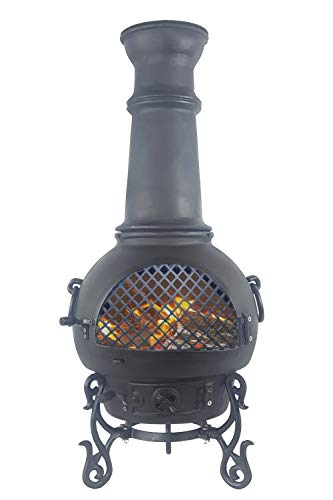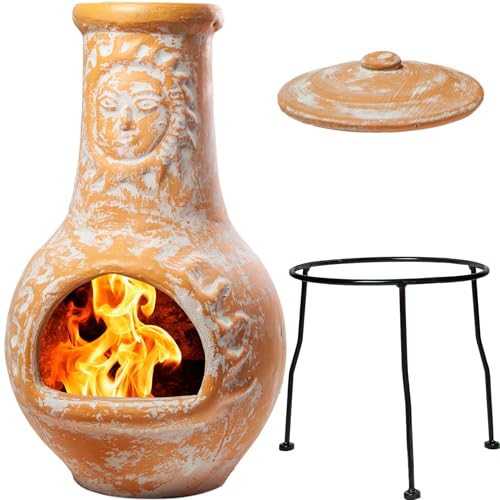자유게시판
| 제목 | Chiminea Fireplaces's History History Of Chiminea Fireplaces |
|---|---|
| 작성자 | Tracy |
| 조회수 | 13회 |
| 작성일 | 24-12-18 09:44 |
| 링크 |
본문
 Chiminea Fireplaces
Chiminea FireplacesFire pits are great however chimineas add an entirely new perspective to fire pits in the backyard. These unique outdoor fireplaces are works of art that create ambiance and warmth for your family gatherings.
 Chimineas must be kept outside and should not be placed directly beneath any material that is flammable. They also must be protected from rainy weather.
Chimineas must be kept outside and should not be placed directly beneath any material that is flammable. They also must be protected from rainy weather.Safety
Whatever type of fire feature you decide to install in your garden, it's important to take precautions for safety. Both fire pits and chimineas are prone to generating sparks that are hot enough to cause burns. They also emit a plume of smoke that could contain pollutants which include secondhand tobacco smoke. Make sure that the area around the chiminea does not contain anything that could ignite. Also keep the chiminea clear from eaves or trees that could catch fire. Additionally, it's best to wear a protective garment when using a chiminea near me, especially if you plan on cooking food on it.
Although both chimineas and pits bring warmth, entertainment, and create a focal point for your outdoor space however, they differ in terms of the aesthetics and lifestyle requirements. Fire pits are more dramatic and can be utilized to complement a broad variety of styles. Chimineas have a rustic more traditional look which is ideal for smaller gardens. They also require more maintenance as they tend to create more smoke than fire pits and require regular cleaning of ash.
In terms of environmental impact, chimineas produce fewer particulate pollutants than traditional fire pits that burn wood due to the fact that they use smoky dryer, and more seasoned wood and result in less emission per usage. Both types of fire pits, however they can release a substantial amount of air pollution in the form of smoke that contains a range of toxic chemicals.
When setting up an e-chiminea near me, ensure to use only seasoned wood and keep the flames to a minimum. It's recommended to put a mesh-screen spark arrester on the top of the chimney. A spark arrester can help limit the production of undesirable sparks that can ignite grass fires or spread the flame to nearby material that is combustible. It's also a good idea not to extinguish a chiminea with water because the abrupt change in temperature could crack terracotta or clay and cause damage to metal.
Both fire pits and chimineas (check out this blog post via stovecanada02345.blog4youth.com) are best used on a fire-safe surface, such as pavers brick, concrete, or slate tiles. The chiminea must be at least 10 feet away from any structure, or any combustible material. It's a good idea to purchase a hose as well as a water container for homeowners so they can quickly extinguish any fires that might occur.
Style
Although fire pits have become extremely popular and may be the most popular option for outdoor fire features, chimineas remain an appealing option for many homeowners. They can give an authentic, Mexican feel to your patio and garden. They also provide warmth during the cooler months. The dimensions of your outdoor space and the type of fuel you want to use will determine if you opt for a chiminea, or a firepit.
Chimineas come in a variety of designs, ranging from the classic terra-cotta rounded design to more modern metal options. Some allow you to use gas instead of wood which is a great alternative when the weather gets cold or it's too windy for an open fire.
Traditional Chimineas have a hollow bottom that houses the firewood which is pumped into the front. The chimney neck is extended up and away from your home and away from drafts. This helps to reduce soot and stops it from getting into food items or on your body when you cook.
Chimineas made from clay and terra-cotta may cause damage if they are too hot, so they work best in spaces which are protected from elements. Cast iron and steel chimineas will endure heat, but they are heavy and difficult to move.
A wood-burning fireplace is a great addition to your patio if you have enough space to accommodate it. You should also keep in mind that chimineas need plenty of space to smoke, so it is important to place them away from any other structures or seating areas to avoid damage and to prevent the ash from blowing up into people's faces.
Chimineas are made of clay or metal, and it will be either painted or natural-looking. If you select a metallic one is likely to have an outer layer of protection that helps repel rust. Some models come with an black finish to give them an elegant look. You can also choose one with a genuine patina of rust, which develops naturally when the metal is exposed to elements.
Fuel
With a wide base that tapers to a narrow chimney chimineas provide the perfect focal point for smaller patios. They are available in various materials and feature handcrafted details. They bring warmth and ambiance to your outdoor living space.
Chimineas reduce unwanted emissions, unlike traditional fire places that burn wood, which can be hazardous to your health. Their enclosed design and upward-directed chimneys help reduce smoke, which can alleviate environmental concerns as well as nuisances to neighbors. This is particularly important if you live in an urban location where excess smoke can cause problems for neighbors.
Chimineas usually burn treated or seasoned wood. However, there are models that can also use charcoal and propane gas for a more versatile cooking experience. If you decide to use fossil fuels such as coal, you'll need to watch your fuel to make sure it doesn't emit excessive smoke.
Like fire pits Chimineas can vary in size, however there are designs that can fit standard logs as well as larger pieces of wood for grilling purposes. Certain chimineas feature features like a grilling grate and a screen, or a rain cap to protect the chimney from falling sparks and other debris. Certain models, such as this one from Bali Outdoors include a screened opening and steel pokers to ignite the fuel safely.
There's a chiminea to suit every style, whether you prefer a rustic or contemporary aesthetic. Most chimineas have a traditional design, but you can also find models with painted or incised details. Some manufacturers, like the Blue Rooster Company that makes our top pick, even provide conversion kits to transform chimineas that burn wood into gas-powered versions.
The best chiminea will provide an enjoyable and safe garden experience. Examine your space, aesthetic preferences and lifestyle needs to determine which chiminea is best suited to you. When you shop, ensure you consider safety features first and maintenance requirements. Also, consider your budget so that you can enjoy the chiminea all through the year.
Maintenance
Although they are simple to use, chimineas need some attention to ensure that they last for a long time and are secure. Cleanliness of your chiminea will prevent the accumulation of ash and debris, which could cause structural damage and fire hazards. Regular cleaning can also improve the appearance of your fireplace outside and enhances its rustic charm.
Although chimineas are mostly wood-burning, gas models can easily be converted to burn propane or natural gas. When using a gas chiminea it is essential to ensure that the chimney is free of any flammable substances like leaves and twigs in order to avoid carbon monoxide poisoning. It is also crucial to only burn dry seasoned wood in your gas chiminea because treated or painted wood releases toxic chemicals when burned.
If you own a clay chiminea it is recommended you line the bowl's bottom with pea gravel. This will prevent the clay from cracking from heat produced by a large fire. It is also advisable to place an aluminum or slate stack cover on top of the chiminea to protect it from rain. Chimineas are designed to be cured or broken down slowly by beginning small fires and then expanding their size over time. After three to four small fires, your chiminea should be ready to handle large logs.
It is crucial to be mindful of local burning laws when using your Chiminea. Be especially cautious during drought conditions, as the continuous smoke from a chiminea can cause neighbors to become angry or demand that you put out your flames.
Chimineas made of clay and steel are both susceptible to cracking or breaking in the event of weather that is too cold or too hot. However, steel structures will be more likely to rust and suffer corrosion than chimineas made of clay. A chiminea made of durable, high-quality materials will ensure that your outdoor fire lasts for many years.
It is recommended to fill the grate with 3 inches of pea gravel or rock sand before using your chiminea. This will prevent the flame from spreading and creating the risk of a fire. It is also a good idea to position your fireplace in a location where winds will blow the smoke away and not blow it into your home. The constant stream of harmful gases could cause issues.




